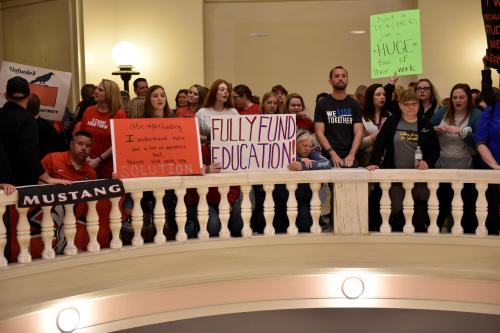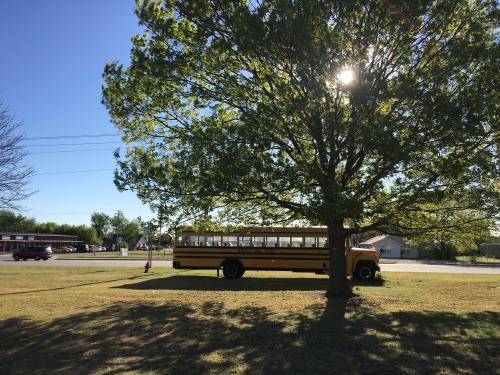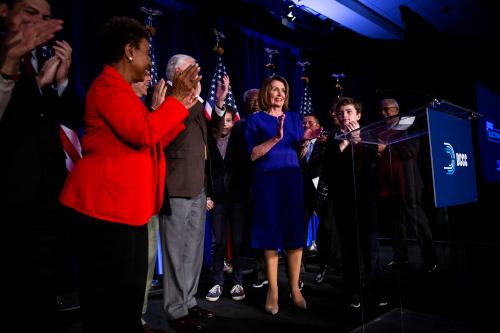National news stories have frequently framed the Oklahoma teacher walkout as a “red-state revolt,” a sudden explosion of dissatisfaction with education funding in the Sooner State. Such a framing is understandable. After all, who expected deep-red Oklahoma to be the site of massive protests over the state of public services? Although the “red-state revolt” framing is intuitive, it greatly oversimplifies a highly complex issue.
Education funding in Oklahoma—and the inseparable issue of teacher salaries—has been a long-simmering frustration of citizens in the state. And while the boil-over of these frustrations has garnered significant headlines, the factors that initially ignited the flame have gone largely unreported. Fully understanding the current teacher walkout requires grasping three interrelated issues: first, the history of teacher labor stoppages in the state; second, institutional rules and partisan composition of the Oklahoma legislature; and finally, prior proposals to address the issue of education funding, particularly with respect to the proposed revenue sources. The teacher walkout is the product of a collision between a fiscally conservative policy environment, citizen frustration with the state of public education, and a structural funding roadblock that has hamstrung policymakers.
The starting point for understanding the current situation in Oklahoma is April 1990, the last time teachers in the state walked off the job. Protesting low pay and poor working conditions, teachers took their case to the state Capitol and lobbied legislators to take swift action on the issue. The legislature responded by passing House Bill 1017 in fairly short order, giving teachers much of what they wanted, including higher pay, smaller class sizes, and an increase in general funding.
However, not everyone was happy with the tax increases contained in the legislation. The ink from Gov. Henry Bellmon’s signature was still drying as the backlash began to take shape. Opponents first brought a repeal effort to the voters in the form of State Question 639. When that failed by a 46-54 margin, these groups focused their efforts on requiring a 75 percent supermajority in each chamber of the Oklahoma legislature in order to increase taxes. This initiative was put to the voters as State Question 640, and it passed with the support of 56 percent of Oklahomans who voted in a low-turnout March 1992 referendum.
State Question 640 has had the effect its supporters intended. From the time the constitutional amendment took effect up through 2017, lawmakers were never once able to marshal enough support behind a revenue measure to satisfy the supermajority requirements. These requirements do not apply to revenue reductions, however, and lawmakers have regularly approved new tax credits over the past quarter century, including a major income tax reduction in the past decade.
The institutional rules governing the legislature—and the policy outcomes they facilitate—have had predictable consequences for K-12 finances in the state, with funding levels over the past 25 years either stagnant or declining, depending upon the state of the economy and, particularly, the price of oil and gas. One oft-cited statistic indicates that, on an inflation-adjusted basis, total per-pupil funding from the state declined nearly 16 percent between 2008 and 2015. The decline is even larger—28 percent—if one only considers general, or formula-based, state funding.
The funding situation has posed challenges for maintaining levels of educational quality in the state. Indeed, about 20 percent of districts in the state operate on a four-day school week, and low salaries have contributed to acute teacher shortages in some districts as qualified educators choose to seek employment in higher-paying states. Given these conditions, Oklahomans have grown increasingly dissatisfied with the level of state support for their schools.
Pessimistic that any legislative proposal to increase education dollars could meet the 75 percent supermajority requirement, education advocates took their initial efforts straight to the voters. The most prominent of these efforts, State Question 779 in the 2016 general election, would have increased the state sales tax by 1 percentage point, with the revenue earmarked for public education. Nearly 70 percent of the revenue would have been allocated to common school districts, funding teacher salary increases of at least $5,000—the remaining 30 percent would have been allocated to postsecondary education.
State Question 779 failed, commanding support from only about 40 percent of the voters. The failure of the referendum, however, cannot simply be interpreted as voters not wanting to increase education funding, although that certainly played a role for some voters. In addition to those who opposed the initiative from the spending side, SQ779 also encountered opposition from those who opposed using the sales tax as the revenue source, particularly liberal groups concerned about regressivity and state municipalities that rely on the sales tax as their primary funding mechanism. Further, because SQ779 was not a preferred solution of elected leadership, these officeholders told voters that they would address teacher pay in the 2017 legislative session if SQ779 failed.
The 2017 legislative session came and went without any notable action on teacher pay or education funding. State lawmakers faced a budget deficit of nearly $900 million and were unable to do any more than maintain education funding at current levels. Because Oklahomans had been told that education funding would be a priority of the legislature, Gov. Mary Fallin sensed citizens’ frustration and recommended that legislators address teacher pay in a special session of the legislature in fall 2017. But once again, in part due to the supermajority requirement, the legislature gaveled out of session on Nov. 17, 2017 without taking action on teacher pay or education funding. Dissatisfied with legislators’ efforts, Fallin issued a call for a second special session, and again included the issue of teacher pay in her call—this second special session is ongoing, running concurrently with the 2018 regular legislative session.
The legislature’s inability to address education funding and teacher pay is the product of an interesting dynamic. Republicans dominate the Oklahoma legislature, holding about 75 percent of House seats and 83 percent of Senate seats, and a strong majority of the caucus supported raising revenue to increase teacher pay. However, a minority of the caucus would not vote to increase taxes under any circumstances, which meant that the GOP needed Democratic votes to meet the supermajority requirement for tax increases. In a stroke of irony, the supermajority requirement gives Democrats significant leverage in any negotiations despite their small number of seats. The Democrats have used this leverage, voting against multiple proposals to increase education funding because the revenue sources were unsatisfactory.
This dynamic put GOP leadership in a tough spot. They could maintain their inaction on education funding and continue drawing the ire of the public, or they could negotiate with Democrats to identify mutually acceptable revenue sources. After a long stalemate, the legislature came to bipartisan agreement on a set of revenue sources. Achieving a supermajority in each chamber, HB1010xx became law on March 29, 2018, increasing cigarette taxes, fuel taxes, and the gross production tax on oil and gas. The signing of HB1010xx represented the first tax increase to pass the Oklahoma legislature since the previous teacher walkout, 28 years earlier. An accompanying piece of legislation, HB1023xx, makes clear that these revenues are slated to fund teacher raises that will average about $6,000, as well as raises of about $1,250 to school support staff, and provide an additional $50 million in general education funding.
So that brings us to where we are today, in the second week of the teacher walk-out with the situation again at a stalemate. Teachers support the new revenues generated by HB1010xx, but are rightfully concerned that they are insufficient to meet the promises made in HB1023xx. Educators have indicated that the walkout will continue until the legislature takes action to fully fund HB1023xx. After all, who knows how long it will be until education is meaningfully addressed again. Fearing that it could be another 28 years, teachers feel that the time is now. Political leadership, on the other hand, feels like they’ve just completed a historic lift, and that expectations for any additional action are simply unrealistic. It remains to be seen how this will play out, but clearly the politics surrounding education in Oklahoma are much more complex than a “red-state revolt.”







Commentary
Not just a ‘red-state revolt’: The story behind the Oklahoma teacher walkout
April 12, 2018